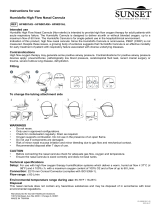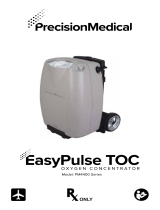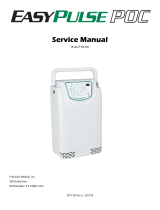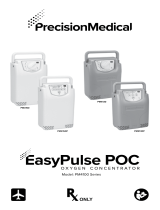PrecisionMedical 1900 Series EasyPulse5, EasyPulse5plus6 Oxygen Conserving Regulator User manual
- Type
- User manual

1900 Series (CGA 870 Connections)
198705 shown

1
CONTENTS
RECEIVING / INSPECTION ................................................................................................... 1
INTENDED USE ....................................................................................................................... 1
READ ALL INSTRUCTIONS BEFORE USING ..................................................................2
EXPLANATION OF ABBREVIATIONS ...............................................................................2
SAFETY INFORMATION....................................................................................................... 2
WARNINGS AND CAUTIONS ............................................................................................. 3
PRINCIPLES OF OPERATION ............................................................................................. 5
SPECIFICATIONS ...................................................................................................................6
COMPONENT DESCRIPTION............................................................................................. 7
INSTALLATION ....................................................................................................................... 8
OPERATING INSTRUCTIONS ............................................................................................. 9
MAINTENANCE / CLEANING .............................................................................................11
RETURNS ................................................................................................................................. 11
DISPOSAL INSTRUCTIONS ................................................................................................11
TROUBLESHOOTING ..........................................................................................................12
REPLACEMENT PARTS .......................................................................................................13
ACCESSORIES .....................................................................................................................13
LIMITED WARRANTY ..........................................................................................................14
RECEIVING / INSPECTION
Remove the Precision Medical, Inc. EasyPulse5 Oxygen Conserving Regulator
(Conserver) from the packaging and inspect for damage. If there is any damage,
DO NOT USE and contact your Provider.
INTENDED USE
To regulate high pressure cylinders that provide supplemental oxygen to patients
who may have diculty extracting oxygen from the air they breathe. It is for patients
who would normally receive the oxygen via a nasal cannula. The device delivers
100% oxygen at flow settings. It is intended to be used as an oxygen saving device
that reduces the drying of the airways.

2
READ ALL INSTRUCTIONS BEFORE USING
This manual instructs the user to install and operate the EasyPulse5 Oxygen
Conserving Regulator (Conserver). This is provided for your safety and to
prevent damage to the Conserver. If you do not understand this manual, DO
NOT USE the Conserver and contact your Equipment Provider.
DANGER
This product is not intended as a life-sustaining or life-supporting device
.
EXPLANATION OF ABBREVIATIONS
kPa Kilopascal
psi Pounds Per Square Inch
l/min Liters Per Minute
b/min Breaths Per Minute
SAFETY INFORMATION - WARNINGS AND CAUTIONS
DANGER Indicates an imminently hazardous situation which, if not
avoided, will result in death or serious injury.
WARNING Indicates a potentially hazardous situation which, if not
avoided, could result in death or serious injury.
CAUTION Indicates a potentially hazardous situation which, if not
avoided, may result in minor or moderate injury.
CAUTION
Used without the safety alert symbol indicates a potentially
hazardous situation which, if not avoided, may result in
property damage.
CONSULT ACCOMPANYING DOCUMENTS
Symbol for “USE NO OIL”
Symbol for “NO SMOKING”
Symbol for “COVERING DEVICE WITH GARMENTS WILL
PRODUCE OXYGEN ENRICHED ATMOSPHERE”

3
WARNING
• You equipment provider is responsible to:
• ensure the compatibility of the oxygen conserving equipment and all
of the parts and accessories used to connect to the patient before use,
• ensure that the oxygen delivery settings were determined and
recorded for the patient individually together with the configuration
of the equipment to be used, including accessories, and
• periodically reassess the setting(s) of the therapy for eectiveness
• Always follow standards for Medical Gas Products, and High Pressure Oxygen Handling. In
the United States, ANSI, CGA and G-4 applies.
• Keep cylinder valve closed at all times when cylinder is not in use.
• NO OXYGEN is delivered when the pointer is aligned with “OFF”.
• CONTRAINDICATION:
The EasyPulse Conserver should not be used for:
• Tracheotomised patient
• Patients who breathe through their mouths or oxygen masks
• Source of oxygen while sleeping
• DO NOT use if dirt or contaminants are present on or around cylinder, valve, the Conserver
or connecting devices.
• DO NOT use oils, greases, organic lubricants or any combustible materials on or near the
Conserver. Wash and dry hands properly prior to use.
• DO NOT use a humidifier with the Conserver.
• DO NOT allow cylinders to tip or fall. Secure gas cylinders so they cannot fall. For
optimum safety keep cylinder upright whenever possible.
• DO NOT store cylinders near sources of heat or flame.
• Smoking during oxygen therapy is dangerous and is likely to result in serious injury or
death of the patient and others from fire.
• There is a risk of fire associated with oxygen equipment and therapy. Do not use near
sparks or open flames.
• Use only medical grade oxygen. In the United States, USP applies.
• The Conserver is equipped with a relief valve. If you hear a loud hissing or popping
sound coming from the Conserver, discontinue use, close cylinder valve, and contact your
Equipment Provider.
• The Conserver is designed to operate with a single lumen, adult cannula with a maximum
length of 7 feet (2.1 m) and a maximum flow of ≥6 l\min.
• To avoid risk of cross contamination, do not reuse the nasal cannula. The cannula is
intended for single patient use only.
• No modification of this equipment is allowed.
• Do not modify this equipment without authorization of the manufacturer.
• If this equipment is modified, appropriate inspection and testing must be conducted to
ensure continued safe use of equipment.

4
WARNING
• DO NOT USE without a seal. For optimum safety, use only a Precision Medical, Inc. Inlet
Seal. The Inlet Seal supplied with the Conserver is reusable. DO NOT USE any other type
of seal.
• To ensure receiving the therapeutic amount of oxygen delivery according to your medical
condition the EasyPulse Conserver must;
• be used only after one or more settings have been individually determined or
prescribed for you at your specific activity levels
• be used with the specific combination of parts and accessories that are in line with
the specification of the oxygen conserver manufacturer and that were used while
your settings were determined.
• The pulse settings of the EasyPulse Conserver might not correspond with continuous
flow oxygen.
• The settings of other models or brands of oxygen therapy equipment do not correspond
with the settings of the EasyPulse Conserver.
• Use only water based lotions or salves that are oxygen compatible during setup or use
during oxygen therapy. Never use petroleum or oil-based lotions or salves to avoid the risk
of fire and burns. Wash and dry hands properly prior to use.
• Do not lubricate replaceable fittings, connections, tubing, or other accessories of the
oxygen conserver to avoid the risk of fire and burns.
• Use only spare parts recommended by the manufacturer to ensure proper function and to
avoid the risk of fire and burns.
• Wind or strong draughts can adversely aect accurate delivery of oxygen therapy.
Using this equipment beside an open window or in front of a fan can aect the accuracy of
delivery of oxygen.
Using this equipment in the back seat of an open convertible car can aect the accuracy of
delivery of oxygen.
• Use of this device at an altitude above 10,000 ft (3048 m) or outside a temperature of 35°F
to 105°F (1.7°C to 40.6°C) is expected to adversely aect the quality of the therapy.
• Oxygen makes it easier for a fire to start and spread. Do not leave the nasal cannula on
bed coverings or chair cushions, if the oxygen conserver is turned on, but not in use; the
oxygen will make the materials flammable. Turn the oxygen conserver o when
not in use.
• If you feel discomfort or are experiencing a medical emergency, seek medical assistance
immediately to avoid harm.
• Geriatric, pediatric or any other patient unable to communicate discomfort can require
additional monitoring to avoid harm.”
• Smoking during oxygen therapy is dangerous and is likely to result in facial burns or death.
Do not allow smoking or open flames within the same room of the oxygen conserver or
any oxygen carrying accessories. If you smoke, you must always turn the oxygen conserver
o, remove the cannula and leave the room where either the cannula or the oxygen
conserver is located. If unable to leave the room, you must wait 10 minutes after the flow of
oxygen has been stopped.

5
PRINCIPLES OF OPERATION
The Oxygen Conserver is designed to be used with high-pressure oxygen
systems. It consists of a cylinder connection, cylinder contents gauge (if
equipped), high-to-low pressure regulator, orifice plate and a conserving
demand module. The regulator reduces the high pressure of the cylinder to
the working pressure of the orifice plate. The orifice plate uses calibrated
orifices to deliver a selected flow to the conserving demand module. The
conserving demand module controls the pulse size and timing to the patient.
It supplies a pulse of oxygen at the beginning of each breath. This reduces the
oxygen demand on the system and limits the drying of the airways. The flow is
determined by setting the flow control knob to the prescribed flow. The oxygen
is supplied to the patient through the cannula.
CAUTION
• Only personnel instructed and trained in its use should operate th
e Conserver
.
• Th
e Conserver
contains magnetic, ferrous material that may aect the results of an MRI.
• DO NOT autoclave.
• DO NOT gas sterilize with Ethylene Oxide.
• DO NOT clean with aromatic hydrocarbons.
• Store the Conserver in a clean area when not in use.
• Avoid dropping the
Conserver
or placing it in a position where it could fall and become
damaged.
• Some respiratory eorts of the patient might not trigger the EasyPulse Conserver. (Shallow
breathers may not be able to trigger the Conserver.) DO NOT USE while sleeping.
• Oxygen delivery settings have to be determined for each patient individually with the
configuration of the equipment to be used, including accessories.

6
SPECIFICATIONS
Inlet Pressure Range: 300 - 3000 psi (2068 - 20684 kPa)
Pressure Gauge Accuracy: 3 - 2 - 3% of full scale
Dimensions: (Are approximate and may vary by model)
Model: 198705
Weight: 9.9 oz (279 g)
Overall Length: 4.75 in (12.07 cm)
Width: 2.63 in (6.67 cm)
Height: 2.50 in (6.35 cm)
Pulse Settings: 1, 2, 3, 4, & 5 l/min Equivalents
Flow Settings:
2 l/min Continuous (198705)
1 through 6 l/min Continuous (198712)
Accuracy:
Continuous Settings: within ± 10%
PULSE ONLY
Accuracy: Pulse Settings: Within +/- 15% of the nominal
bolus value (at each breath rate)
Savings Ratio: Up to 5.7:1
Trigger Method: Inspiratory eort (Negative pressure from
patient inhalation)
Breathing Frequency: Up to 35 b/min
Cannula Requirement: Maximum 7 foot (2.1 m) long standard adult
single lumen nasal cannula.
Operating Conditions:
Temperature: 35°F to 105°F (1.7°C to 40.6°C)
Altitude: Sea level to 10,000 ft (0 to 3,048 m)
Storage Conditions:
Temperature: -40°F to 140°F (-40°C to 60°C)
Maximum Humidity: 95% Noncondensing
Oxygen Cylinder Connection:
CGA 540 Valve
Ignition and Fault Tolerance: Meets ASTM G175-03
Specifications are subject to change without prior notice. Manuals available on our website: www.precisionmedical.com
Specifications for the flowrates and volume for the gas delivered to the patient are expressed in STPD (standard temperature and
pressure dry) conditions.(14.69 psi (101,3 kPa) at an operating temperature of 68 °F (20 °C)), dry
Specification tolerances include the uncertainty of the measurement used to determine the specification.

7
COMPONENT DESCRIPTION
CAUTION
Missing or illegible labels must be replaced, contact Precision Medical, Inc.
Index
Pins
Yoke
Seal
Cannula
Connection
T-Handle
Dial
Contents
Gauge
Indicator
Pointer
(198705 shown)

8
INSTALLATION
WARNING
• Read this User Manual before installing or operating the Oxygen
Conserving Regulator.
• Inspect the Conserver and cylinder valve to ensure they are free of
oils, greases or other contaminants.
• DO NOT direct flow of oxygen at any person, or flammable material
when cracking open the cylinder.
• DO NOT use without yoke seal.
• DO NOT use plastic yoke seals.
• Use Precision Medical, Inc. yoke seal made of viton and brass.
• The yoke seal supplied with the Conserver is reusable.
CAUTION
• Inspect the Oxygen Conserving Regulator for visual damage before
use, DO NOT USE if damaged.
• DO NOT use tools to tighten T-handle, this can lead to over tightening
and will cause damage to the Conserver.
• Be sure all connections are tight and leak free.
• DO NOT use liquid leak detector to test for leaks.
Note: For Operational Instructions on how to operate the cylinder
consult with your Equipment Provider.
1. Position the cylinder so the oxygen cylinder valve outlet is pointing
away from the user and any other person(s).
2. Before installing the Conserver, “crack” cylinder valve by opening
the valve slightly to remove any foreign particles and then
close valve.
3. Be sure the Conserver is in the “OFF” position. Align “OFF” with the
indicating pointer .
4. Be sure the CGA 870 connection high pressure inlet has a
yoke seal.
5. Align Index Pins with Index Pin Alignment Holes in Post Valve.
6. Hand tighten T-handle until snug.

9
OPERATING INSTRUCTIONS
1. Attach a standard adult single lumen oxygen nasal cannula, no
longer than 7 feet (2.1 m) to the Conserver’s outlet according to the
cannula manufacturer’s instructions.
CAUTION
• Use of incompatible accessories can result in degraded performance.
• DO NOT block the cannula connection or kink cannula tubing when
the Conserver is in use, this may damage the Conserver.
• The proper placement and positioning of the nasal cannula in the nose
is critical to the consistent operation of this equipment.
2. Place the cannula over your ears and position the prongs in your
nose as instructed by your Provider or cannula manufacturer.
3. Slowly open cylinder valve counterclockwise, until completely open.
4. Turn dial on the Conserver until indicating pointer is aligned with
the prescribed setting.
5. Breathe through your nose.
OR
NOTE: • When on a pulse setting, there is flow or a pulse only
at the beginning of each breath. If you do not feel
the pulse at the beginning of each breath, check
the setting. If there is still no pulse, turn dial to an
equivalent “Continuous” setting.
• Because each patient’s breathing pattern is dierent
and the environment varies, it may be dicult to feel
some low setting pulses.

10
6. To remove the Conserver from cylinder:
• Completely close oxygen cylinder valve.
• Turn the Conserver dial to any “Continuous” position.
• Wait for oxygen to stop flowing from Conserver.
• Remove the Conserver from cylinder valve.
• DO NOT try to loosen T-handle beyond stop. Damage to the
Conserver will occur.
DANGER
NEVER attempt to remove the Conserver from a cylinder unless
the cylinder valve is closed.
WARNING
• When pointer on contents gauge enters red zone, (500 psi (3447 kPa)
and below), it is recommended to change to a full oxygen cylinder.
• NO OXYGEN is delivered in between settings.
WARNING
• Use only Precision Medical, Inc. carry bag designed for the
EasyPulse5 to prevent an oxygen enriched environment.
• DO NOT place the unit under clothing while in use. When the
Conserver is in use, a small amount of oxygen is vented. Wearing the
unit under clothing may saturate fabrics with oxygen and cause them
to burn rapidly, if exposed to sparks or flame. It may take several hours
for oxygen levels in fabrics to return to normal.
• ALWAYS insert cylinder and Conserver into bag, cylinder first with
gauge facing mesh. Reference accessory photo, (pg. 13).

11
MAINTENANCE / CLEANING
1. Disconnect all connections before cleaning.
2. Clean exterior surfaces of the Conserver with a cloth dampened with
mild detergent and water.
3. Wipe dry with a clean cloth.
4. Store the Conserver in a clean area free of grease, oil, and other
sources of contamination.
Please Recycle
RETURNS
Returned products require a Returned Goods Authorization (RGA)
number, contact Precision Medical, Inc. All returns must be packaged in
sealed containers to prevent damage. Precision Medical, Inc. will not be
responsible for goods damaged in transit. Refer to Precision Medical,
Inc. Return Policy available on the Internet, www.precisionmedical.com.
DISPOSAL INSTRUCTIONS
This device and its packaging contain no hazardous materials. No
special precautions need to be taken when disposing the device and/
or its packaging.
CAUTION
• DO NOT use cleaning solutions.
• DO NOT immerse the Conserver in any kind of liquid.
• DO NOT attempt to repair the EasyPulse5 Oxygen Conserving
Regulator.
• All repairs must be performed by Precision Medical, Inc. or Authorized
Representative.

12
TROUBLESHOOTING
If the Conserver fails to function, consult the Troubleshooting Guide
below. If problem cannot be solved, consult your Provider.
TROUBLESHOOTING GUIDE
Problem Probable Cause Remedy
No flow 1. Cylinder valve
closed
2. Conserver in “OFF”
position
3. Cylinder empty
4. Dial not set at
proper position
5. Conserver not
sensing breath
1. Open the valve on
cylinder
2. Set to prescribed
setting
3. Replace cylinder
4. Set dial so indicator
points to a setting
5. Check position of
cannula in nose,DO
NOT breathe through
mouth
Leaking at
cylinder
connection
1. Missing or defective
yoke seal
2. Defective cylinder
valve
1. Replace with Precision
Medical yoke seal
2. Contact your Provider

13
REPLACEMENT PARTS
Description Part #
Cannula 504833
Yoke Seal 1221
Carry Bag with
shoulder strap
Conserver properly
installed in Carry Bag
ACCESSORIES
Description Part #
Carry Bag M6 503920
Carry Bag M4/M6 504184
Carry Bag ML6/ML9 504185

14
LIMITED WARRANTY
AND LIMITATION OF LIABILITY
Precision Medical, Inc. warrants that the Easy Pulse Oxygen Conserving
Regulator (the Product) will be free of defects in workmanship and/or material
for the following periods:
Two (2) years from date of shipment.
Should any failure to conform to this warranty appear within the applicable
period, Precision Medical, Inc. shall, upon written notification thereof and
substantiation that the goods have been stored, installed, maintained and
operated in accordance with Precision Medical, Inc.’s instructions and standard
industry practice, and that no modifications, substitutions, or alterations have
been made to the goods, correct such defect by suitable repair or replacement
at its own expense.
ORAL STATEMENTS DO NOT CONSTITUTE WARRANTIES.
The representative of Precision Medical, Inc. or any retailers are not authorized
to make oral warranties about the merchandise described in this contract, and
any such statements shall not be relied upon and are not part of the contract
for sale. Thus, this writing is a final, complete and exclusive statement of the
terms of that contract.
THIS WARRANTY IS EXCLUSIVE AND IS IN LIEU OF ANY WARRANTY OF
MERCHANTABILITY, FITNESS FOR A PARTICULAR PURPOSE OR OTHER
WARRANTY OF QUALITY, WHETHER EXPRESS OR IMPLIED.
Precision Medical, Inc. shall not under any circumstances be liable for special,
incidental or consequential damages including but not limited to lost profits, lost
sales, or injury to person or property. Correction of non-conformities as provided
above shall constitute fulfillment of all liabilities of Precision Medical, Inc. whether
based on contract, negligence, strict tort or otherwise. Precision Medical, Inc.
reserves the right to discontinue manufacture of any product or change product
materials, designs, or specifications without notice.
Precision Medical, Inc. reserves the right to correct clerical or typographical
errors without penalty.

507628 Rev4 Printed in USA
300 Held Drive
Northampton PA 18067, USA
www.precisionmedical.com
T:
(+001) 610-262-6090 • F: (+001) 610-262-6080
ISO 13485 Certified
-
 1
1
-
 2
2
-
 3
3
-
 4
4
-
 5
5
-
 6
6
-
 7
7
-
 8
8
-
 9
9
-
 10
10
-
 11
11
-
 12
12
-
 13
13
-
 14
14
-
 15
15
-
 16
16
PrecisionMedical 1900 Series EasyPulse5, EasyPulse5plus6 Oxygen Conserving Regulator User manual
- Type
- User manual
Ask a question and I''ll find the answer in the document
Finding information in a document is now easier with AI
Other documents
-
 Precision Medical EasyPulse5/5+6 Oxygen Conserving Regulator User manual
Precision Medical EasyPulse5/5+6 Oxygen Conserving Regulator User manual
-
 SUNSET HEALTHCARE SOLUTIONS HFN001AS User manual
SUNSET HEALTHCARE SOLUTIONS HFN001AS User manual
-
 Precision Medical Easy Pulse 5 Oxygen Conserving Regulator User guide
Precision Medical Easy Pulse 5 Oxygen Conserving Regulator User guide
-
Drive CH4815-L-BLUE Owner's manual
-
 Precision Medical PM4400 User manual
Precision Medical PM4400 User manual
-
 Precision Medical PM4100 Series EasyPulse POC User manual
Precision Medical PM4100 Series EasyPulse POC User manual
-
Graham Field JB0150-081 User manual
-
Drive Medical CTOX-MN02 Owner's manual
-
 Precision Medical PM4100 series User manual
Precision Medical PM4100 series User manual
-
Invacare IOC100P User manual





















